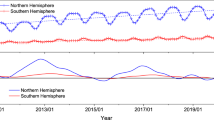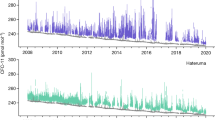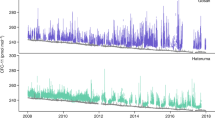Abstract
Chloroform contributes to the depletion of the stratospheric ozone layer. However, due to its short lifetime and predominantly natural sources, it is not included in the Montreal Protocol that regulates the production and uses of ozone-depleting substances. Atmospheric chloroform mole fractions were relatively stable or slowly decreased during 1990–2010. Here we show that global chloroform mole fractions increased after 2010, based on in situ chloroform measurements at seven stations around the world. We estimate that the global chloroform emissions grew at the rate of 3.5% yr−1 between 2010 and 2015 based on atmospheric model simulations. We used two regional inverse modelling approaches, combined with observations from East Asia, to show that emissions from eastern China grew by 49 (41–59) Gg between 2010 and 2015, a change that could explain the entire increase in global emissions. We suggest that if chloroform emissions continuously grow at the current rate, the recovery of the stratospheric ozone layer above Antarctica could be delayed by several years.
This is a preview of subscription content, access via your institution
Access options
Access Nature and 54 other Nature Portfolio journals
Get Nature+, our best-value online-access subscription
$29.99 / 30 days
cancel any time
Subscribe to this journal
Receive 12 print issues and online access
$259.00 per year
only $21.58 per issue
Buy this article
- Purchase on Springer Link
- Instant access to full article PDF
Prices may be subject to local taxes which are calculated during checkout


Similar content being viewed by others
Data availability
The data that support the findings of this study are available from the corresponding author upon request. CHCl3 measurement data for East Asia can be accessed by contacting data leads: S.P. (sparky@knu.ac.kr) for GSN and T.S. (saito.takuya@nies.go.jp) for HAT. CHCl3 measurement data for the five non-Asian AGAGE stations (CGO, SMO, RPB, THD and MHD) used in this study are available at http://agage.mit.edu/data/agage-data/.
References
Scientific Assessment of Ozone Depletion: 2014 Global Ozone Research and Monitoring Project, Report No. 55 (WMO, 2014).
Navarro, M. A. et al. Airborne measurements of organic bromine compounds in the Pacific tropical tropopause layer. Proc. Natl Acad. Sci. USA 112, 13789–13793 (2015).
Sala, S. et al. Deriving an atmospheric budget of total organic bromine using airborne in situ measurements from the western Pacific area during SHIVA. Atmos. Chem. Phys. 14, 6903–6923 (2014).
Laube, J. C. et al. Contribution of very short-lived organic substances to stratospheric chlorine and bromine in the tropics—a case study. Atmos. Chem. Phys. 8, 7325–7334 (2008).
Hossaini, R. et al. Efficiency of short-lived halogens at influencing climate through depletion of stratospheric ozone. Nat. Geosci. 8, 186–190 (2015).
Sinnhuber, B. M. & Meul, S. Simulating the impact of emissions of brominated very short lived substances on past stratospheric ozone trends. Geophys. Res. Lett. 42, 2449–2456 (2015).
Salawitch, R. J. et al. Sensitivity of ozone to bromine in the lower stratosphere. Geophys. Res. Lett. 32, 811–815 (2005).
Hossaini, R. et al. The increasing threat to stratospheric ozone from dichloromethane. Nat. Commun. 8, 15962–15970 (2017).
McCulloch, A. Chloroform in the environment: occurrence, sources, sinks and effects. Chemosphere 50, 1291–1308 (2003).
Scientific Assessment of Ozone Depletion: 2010 Global Ozone Research and Monitoring Project, Report No. 52 (WMO, 2011).
Trudinger, C. M. et al. Atmospheric histories of halocarbons from analysis of Antarctic firn air: methyl bromide, methyl chloride, chloroform, and dichloromethane. J. Geophys. Res. Atmos. 109, 310–324 (2004).
Worton, D. R. et al. 20th century trends and budget implications of chloroform and related tri- and dihalomethanes inferred from firn air. Atmos. Chem. Phys. 6, 2847–2863 (2006).
Prinn, R. G. et al. History of chemically and radiatively important atmospheric gases from the Advanced Global Atmospheric Gases Experiment (AGAGE). Earth Syst. Sci. Data 10, 985–1018 (2018).
Stohl, A., Hittenberger, M. & Wotawa, G. Validation of the Lagrangian particle dispersion model FLEXPART against large-scale tracer experiment data. Atmos. Environ. 32, 4245–4264 (1998).
Jones, A., Thomson, D., Hort, M. & Devenish, B. in Air Pollution Modeling and Its Application XVII (eds Borrego C. & Norman A.-L.) 580–589 (Springer, New York, 2007).
Ganesan, A. L. et al. Characterization of uncertainties in atmospheric trace gas inversions using hierarchical Bayesian methods. Atmos. Chem. Phys. 14, 3855–3864 (2014).
Montzka, S. A. et al. An unexpected and persistent increase in global emissions of ozone-depleting CFC-11. Nature 557, 413–417 (2018).
Lunt, M. F. et al. Continued emissions of the ozone-depleting substance carbon tetrachloride from Eastern Asia. Geophys. Res. Lett. 35, 11423–11430 (2018).
Park, S. et al. Toward resolving the budget discrepancy of ozone-depleting carbon tetrachloride (CCl4): an analysis of top-down emissions from China. Atmos. Chem. Phys. 18, 11729–11738 (2018).
Vollmer, M. K. et al. Atmospheric histories and emissions of chlorofluorocarbons CFC-13 (CClF3), ΣCFC-114 (C2Cl2F4), and CFC-115 (C2ClF5). Atmos. Chem. Phys. 18, 979–1002 (2018).
Assessment for Decision-Makers: Scientific Assessment of Ozone Depletion: 2014 Global Ozone Research and Monitoring Project, Report No. 56 (WMO, 2014).
Hossaini, R. et al. A multi-model intercomparison of halogenated very short-lived substances (TransCom-VSLS): linking oceanic emissions and tropospheric transport for a reconciled estimate of the stratospheric source gas injection of bromine. Atmos. Chem. Phys. 16, 9163–9187 (2016).
Yu, P. et al. Efficient transport of tropospheric aerosol into the stratosphere via the Asian summer monsoon anticyclone. Proc. Natl Acad. Sci. USA 114, 6972–6977 (2017).
Randel, W. J. et al. Asian monsoon transport of pollution to the stratosphere. Science 328, 611–613 (2010).
Vogel, B. et al. Fast transport from Southeast Asia boundary layer sources to northern Europe: rapid uplift in typhoons and eastward eddy shedding of the Asian monsoon anticyclone. Atmos. Chem. Phys. 14, 12745–12762 (2014).
Oram, D. E. et al. A growing threat to the ozone layer from short-lived anthropogenic chlorocarbons. Atmos. Chem. Phys. 17, 11929–11941 (2017).
Ashfold, M. J. et al. Rapid transport of East Asian pollution to the deep tropics. Atmos. Chem. Phys. 15, 3565–3573 (2015).
Orbe, C., Waugh, D. W. & Newman, P. A. Air-mass origin in the tropical lower stratosphere: the influence of Asian boundary layer air. Geophys. Res. Lett. 42, 4240–4248 (2015).
Lu, L. China’s Fuoropolymer Production Capacity Will Be 230,000 Tons By 2020, and PTFE Will Account For 70% (in Chinese) (Qianzhan, 2017); https://www.qianzhan.com/analyst/detail/220/170629-c33a2ca7.html
Rigby, M. et al. Re-evaluation of the lifetimes of the major CFCs and CH3CCl3 using atmospheric trends. Atmos. Chem. Phys. 13, 2691–2702 (2013).
Cunnold, D. M. et al. The Atmospheric Lifetime Experiment: 3. Lifetime methodology and application to three years of CFCl3 data. J. Geophys. Res. Oceans 88, 8379–8400 (1983).
Rigby, M., Ganesan, A. L. & Prinn, R. G. Deriving emissions time series from sparse atmospheric mole fractions. J. Geophys. Res. Atmos. 116, 306–310 (2011).
Xiao, X. Optimal Estimation of the Surface Fluxes of Chloromethanes Using a 3-D Global Atmospheric Chemical Transport Model. PhD thesis, Massachusetts Institute of Technology, 2008.
Rigby, M. et al. Recent and future trends in synthetic greenhouse gas radiative forcing. Geophys. Res. Lett. 41, 2623–2630 (2014).
Enomoto, T., Yokouchi, Y., Izumi, K. & Inagaki, T. Development of an analytical method for atmospheric halocarbons and its application to airborne observation (in Japanese). J. Jpn Soc. Atmos. Environ. 40, 1–8 (2005).
Yokouchi, Y. et al. High frequency measurements of HFCs at a remote site in east Asia and their implications for Chinese emissions. Geophys. Res. Lett. 33, 814–817 (2006).
Miller, B. R. et al. Medusa: A sample preconcentration and GC/MS detector system for in situ measurements of atmospheric trace halocarbons, hydrocarbons, and sulfur compounds. Anal. Chem. 80, 1536–1545 (2008).
Stohl, A., Forster, C., Frank, A., Seibert, P. & Wotawa, G. Technical note: The Lagrangian particle dispersion model FLEXPART version 6.2. Atmos. Chem. Phys. 5, 2461–2474 (2005).
Lunt, M. F., Rigby, M., Ganesan, A. L. & Manning, A. J. Estimation of trace gas fluxes with objectively determined basis functions using reversible-jump Markov chain Monte Carlo. Geosci. Model Dev. 9, 3213–3229 (2016).
Acknowledgements
X.F., R.G.P. and A.G. are supported by the National Aeronautics and Space Administration (NASA) grant nos NAG5-12669, NNX07AE89G, NNX11AF17G and NNX16AC98G to MIT. T.S., Y.Y. and the Hateruma station are supported fully by the Ministry of Environment of Japan and NIES. S.P., S.L. and the Gosan AGAGE station are supported by the Basic Science Research Program through the National Research Foundation of Korea (NRF) funded by the Ministry of Education (no. NRF-2016R1A2B2010663). R.T. was funded under Natural Environment Research Council (NERC) grant no. NE/M014851/1. A.L.G. was funded under a NERC Independent Research Fellowship (NE/L010992/1). M.R. was funded under a NERC Advanced Fellowship (NE/I021365/1). P.J.F., P.B.K. and the CGO AGAGE station are supported by CSIRO, the Bureau of Meteorology, Refrigerant Reclaim Australia and NASA grants to MIT. The operations of the AGAGE stations were/are supported by the NASA (grant nos NAG5-12669, NNX07AE89G, NNX11AF17G and NNX16AC98G to MIT; grant nos NAG5-4023, NNX07AE87G, NNX07AF09G, NNX11AF15G, NNX11AF16G, NNX16AC96G and NNX16A97G to SIO). In addition to the NASA funding, MHD was/is supported by the Department for Business, Energy & Industrial Strategy (BEIS, UK, formerly the Department of Energy and Climate Change (DECC)) contract nos GA01081, GA0201, 1028/06/2015 and 1537/06/2018 to the University of Bristol and the UK Meteorological Office. The RPB station was/is also additionally supported by the National Oceanic and Atmospheric Administration (NOAA), contract nos RA-133-R09-CN-0062 and RA-133-R15-CN-0008 to the University of Bristol; the NOAA supports the operations of the SMO station.
Author information
Authors and Affiliations
Contributions
X.F. and R.G.P. were responsible for the overall project design. M.R. contributed to the global emission estimation. X.F. contributed to the FLEXPART-based inversions. A.L.G., R.T., A.J.M. and M.F.L. contributed to NAME-based inversions. T.S. and Y.Y. provided the CHCl3 measurement data from HAT, Japan. S.P. and S.L. provided the CHCl3 measurement data from GSN, South Korea. Other co-authors provided the CHCl3 measurement data from the five AGAGE stations and the SIO/NIES calibration scales intercomparison data. The manuscript was written by X.F., M.R., A.L.G., J.M., and P.J.F. with contributions from all co-authors.
Corresponding authors
Ethics declarations
Competing interests
The authors declare no competing interests.
Additional information
Publisher’s note: Springer Nature remains neutral with regard to jurisdictional claims in published maps and institutional affiliations.
Supplementary information
Supplementary Information
Supplementary Description, Supplementary Figures 1–6 and Supplementary Tables 1–5.
Rights and permissions
About this article
Cite this article
Fang, X., Park, S., Saito, T. et al. Rapid increase in ozone-depleting chloroform emissions from China. Nature Geosci 12, 89–93 (2019). https://doi.org/10.1038/s41561-018-0278-2
Received:
Accepted:
Published:
Issue Date:
DOI: https://doi.org/10.1038/s41561-018-0278-2
This article is cited by
-
CCl4 emissions in eastern China during 2021–2022 and exploration of potential new sources
Nature Communications (2024)
-
Sustained growth of sulfur hexafluoride emissions in China inferred from atmospheric observations
Nature Communications (2024)
-
A review on atmospheric volatile halogenated hydrocarbons in China: ambient levels, trends and human health risks
Air Quality, Atmosphere & Health (2024)
-
Very short-lived halogens amplify ozone depletion trends in the tropical lower stratosphere
Nature Climate Change (2023)
-
Natural short-lived halogens exert an indirect cooling effect on climate
Nature (2023)



